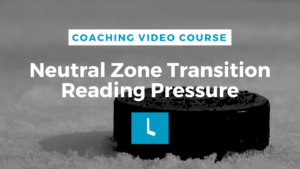(Transcribed from How to Play Hockey: Our Minor Hockey Coaching Course.)
A lot of videos in this module about defensive tactics will go into smaller details for you, and go over some very basic principles of defensive zone coverage here in this video.
- Where to cover
- How to cover
- How close to cover
[maxbutton id=”2″ ]
Imagine that I have divided the defensive zone into four quadrants. We have left defense, right defense, right wing and left wing. You’ll notice in the video that I’ve left out the goalie. Let’s assume they’re trying to prevent goals. I’ve also left out the center which I’ll get to in a moment. Each of these positions end up at different times going to different areas of their quadrant depending on the player that they’re covering.
In general our RW would not come over too far beyond the halfway point of the zone and that would only be when the puck is on the far side and the LW is being a little bit more aggressive, covering his/her defense. If the puck is in the strong side corner for the LW, the RW would not want to be all the way across the zone on the far right side of his/her quadrant. We need to shfit together, generally being a shorter distance, maybe half the ice apart maximum at any one time.
You’ll notice in another video, the prime scoring area cuts through these quadrants. So the RW and the LW have the freedom to collapse down into the prime scoring area as low even as the hash marks to prevent a goal. As the puck comes back out they would come up to cover their D. So there’s an overlap here of the prime scoring area and the quadrant which I find as a really important point. The same applies for the LD and the RD in that they’re working together and rarely end up on exactly the same side of the ice. If the LD ends up in the corner battling for the puck, the RD generally is somewhere in front of the net and it would be a C supporting.
Here is where the C comes into play. We like to think about layers of an onion. The puck battle in is the first layer. It’s generally the first player into the corner but ideally it would be the D1. The next layer of the onion is the C in a more supportive role. If the C is in first then the secondary support would be the D1. One player, first one, is battling hard on the wall. The next player is ready to jump if they see the puck come loose or if there’s a second attacker from the opposing team.
If the puck switches sides, D2 would engage in the first layer of the onion and the C would hustle across in front of the net into the second layer of the onion to support here.
I guess we could think about this next layer of the onion being quite a bit bigger and that the other D and the other W may have to come to the edges of that third layer in order to help out. And consider that they want to arrive at these points where their quadrant intersects with the onion. If the puck is right in front of the net as we’ve talked about in other videos, generally we all need to condense and perhaps even leave our quadrants and just try to tie up a step, one player against one player, man-on-man defensive zone coverage.
So again, just to recap. We have the four quadrants, we have a zone for each W, a zone for each D and for the most part while we don’t have the puck, the C is going to cover the bottom quadrants. If the puck comes out towards the blue and a W has to come out then the C may come out to support but should be trying to cover a player from the other team. So we have this mix of zone and man-on man-defense. Once we win the puck we become offensive and we need to support each other. But we’ll get to that in the breakout section of this course.
You’re constantly changing from defense to offensive. You have two jobs in the defensive zone. You’re defending or you’re breaking out. If you lose the puck, you’re back to defending and again we will talk about that more in the transition from defense to offense and for today we’ll stick more strictly with the defensive zones of coverage and the defensive zone.
Hockey can be complicated. There are different philosophies, different techniques. But in general there are some common principles that will join all of these different systems and tactics together. And the quicker you can read the transitions from defense to offense the better player you’ll be and more valuable player you will be on your team.
We’ll see you in the next video!
Looking to download half ice hockey practice plans, goalie drills for teams (not a goalie coach?!) or small area games drills? We’ve got you covered too. Click here. Perfect for recreational level coaches.





